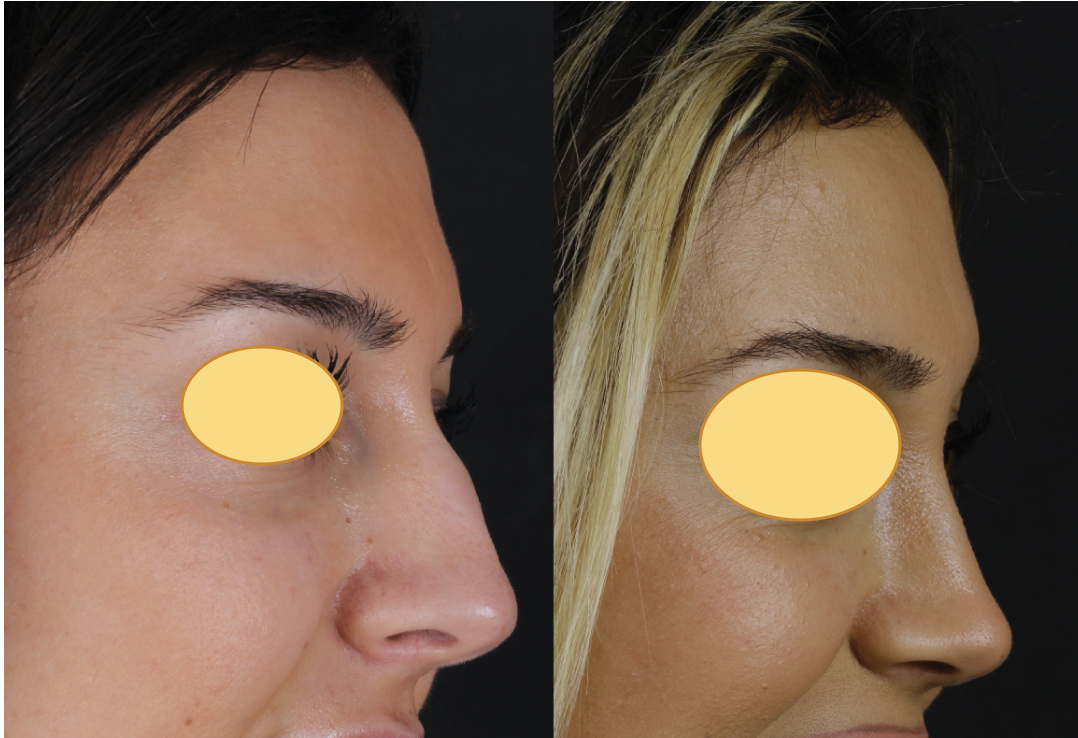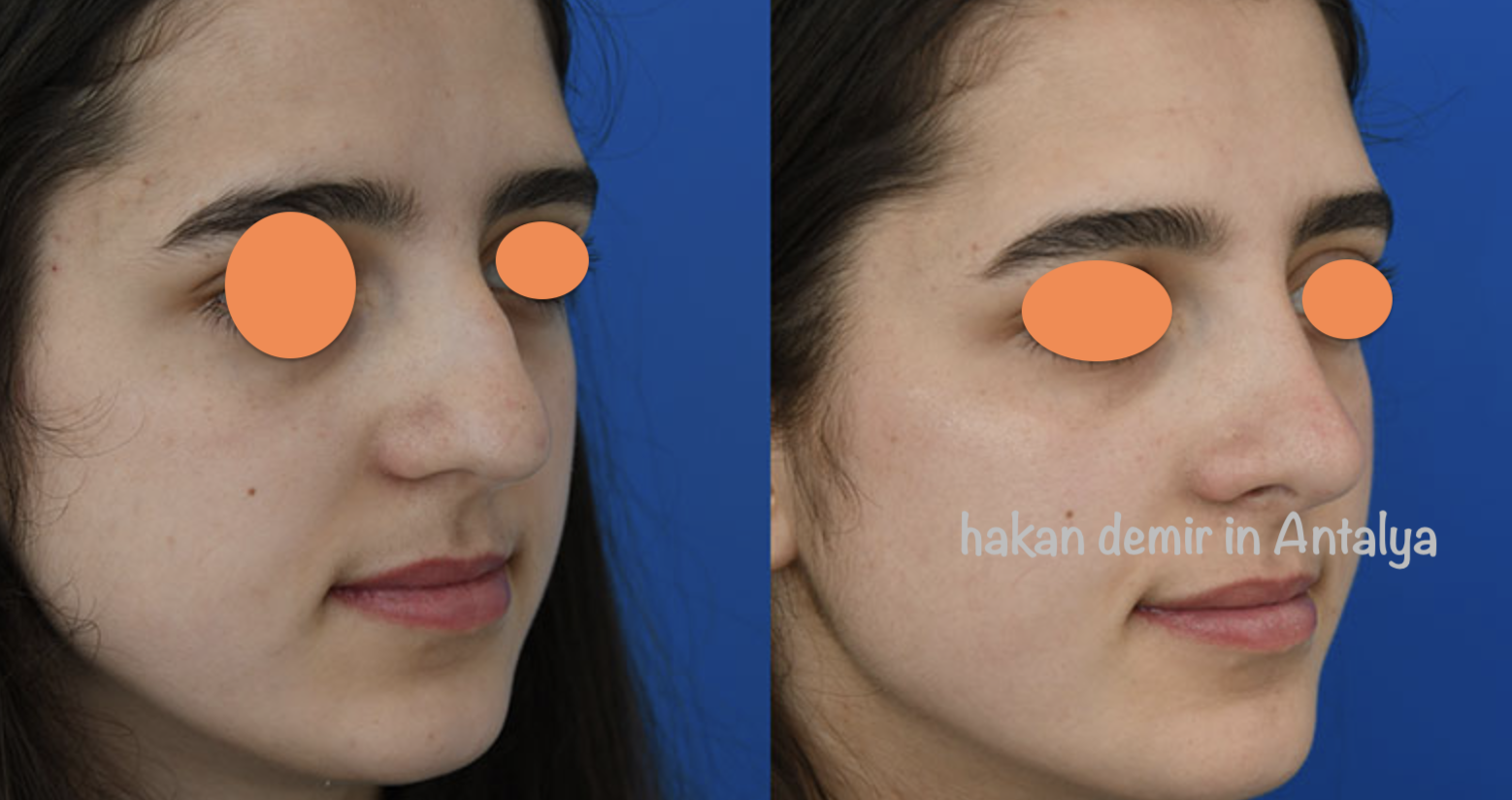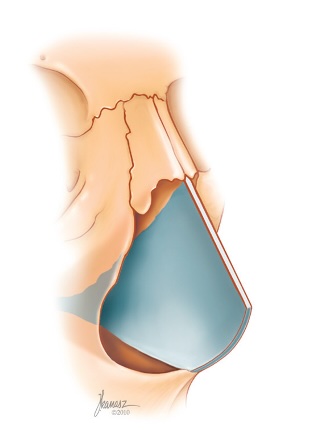Nose job in Antalya in Turkey
Your nose should "blend" into your face, becoming sleek and balanced without flaws that might attract the observer’s gaze. Keeping that in mind, it is paramount that you evaluate "real" before and after photos of the surgeon’s work and by no means settle for a computer simulation-"the computer will not be performing the surgery-the surgeon will."
Rhinoplasty (nose job ) can be performed to alter nasal size or shape whether it is traumatic or genetically acquired. Unattractive nasal features such as a wide bulbous tip, wide nasal bridge, large dorsal hump, malformed/asymmetric tip, crooked nose, or a deviated septum causing breathing problems are readily correctable. Even in the case of prior surgery, the nose can most often be substantially softened and the overall shape vastly improved. I'm used to piezo machine for reshapıng bones in the nose operation

Procedure
The surgery entails reshaping the nasal skeleton that is comprised of cartilage and bone. Once the nasal skeletal structure is visualized, appropriate modifications can be performed to achieve the desired results. It is frequently necessary to modify all three areas of the nose in order to assure aesthetic harmony and balance. Cartilage of the nasal tip is deftly and precisely sculpted while the nasal bones are shaped and thinned. Once this is achieved-a natural and refined appearance will follow. We are used to piezo for remodeling nasal bones
The incisions are well camouflaged within the nose and there is little, pain, swelling or discomfort following the procedure. Following the procedure, you will have follow up appointments with Dr. Demir, in order to monitor your healing and progress. Most patients return to their normal routine in 1 week but avoid strenuous activity for 2 weeks and physical (rough) contact with the nose for 1 month. The nasal shape will continue to improve over the subsequent months
Revision Rhinoplasty
A significant portion of Dr. Demir's practice is devoted to revision rhinoplasty (correcting problems from a previous rhinoplasty). Revision rhinoplasty is needed when a primary rhinoplasty does not adequately resolve cosmetic or functional issues, or when specific imbalances arise post-surgery or worsen. If the nose, for example, is not in balance with other facial features due to problems from previous surgery or unanticipated issues associated with poor healing, revision rhinoplasty may be indicated. With the typical reductive rhinoplasty techniques, is not unusual for the patient to have an improvement in the appearance of their nose early postoperative and then deform over time. Dr. Demir's structure techniques are designed to provide a good long-term outcome. The patient must understand that their nose will look swollen and possibly wider early on, only to improve with time.
For these reasons, revision rhinoplasty can be more complex than a first surgery. That is why a surgeon specialized in revision/correction is critical. Successful revision rhinoplasty surgeons typically have – and should have – experience with more complex issues around structure and function that may have been compromised or incompletely addressed by primary surgery. For you the patient, your personal treatment, appearance, and structural/functional goals are even more critical to address and fulfill via revision rhinoplasty, for obvious reasons
To this end, Dr. Demir’s experience and expertise with revision rhinoplasty are unmatched – as he performs more than 200 such procedures each year. He believes that every detail of revision rhinoplasty is more complex than with primary rhinoplasty, and is magnified by the hesitancy many patients express around additional surgery. The revision rhinoplasty surgeon, then, should be committed to an even higher level of sensitivity to the patient’s concerns and commitment to the patient’s needs, wishes, and desired results.
Over his 20+ years of practice, he has mastered and refined – and continues to refine – his technique. This has included replacing ear cartilage used in secondary cases with rib (costal) cartilage, for example. This critical adaptation of technique – detailed in many of Dr. Demir’s peer-reviewed papers and other writings – reflected his recognition that the use of ear cartilage, a less complex procedure, sometimes did not produced the long-term results patients demand, with some instances of ear cartilage being pinched, leading to somewhat compromised nasal function.
Rib cartilage, on the other hand, is high-quality and strong, producing resilient and durable grafting material. Dr. Demir adapted and refined a revolutionary technique that allows for very thin costal cartilage grafts that are strong to support long-term function – a technique that requires a smaller initial incision that, combined with reduced dissection, minimizes recovery discomfort and time.

For a majority of revision rhinoplasty patients, Dr. Demir must construct a new supporting nasal structure to provide a proper shape. These major reconstructions are extremely difficult and necessitate an accurate understanding of three-dimensional nasal contours.
When a patient undergoes a revision rhinoplasty procedure, scar tissue can develop that can complicate subsequent reconstructions. Dr. Demir understands that there is a large degree of variability in revision rhinoplasty deformities. Some patients have problems that are difficult to correct. For this reason, some noses can be effectively corrected while others have a higher risk of problems or persistent deformity that may require an additional surgery (revision).
Dr. Demir emphasizes preservation with minimal excision.
Dr. Demir’s techniques enhance the preservation of your nasal structures while limiting the need for excision of supporting tissues. He avoids removing too much of the supporting structures because it can result in a pinched, upturned tip with nasal obstruction – an “operated look”. The use of cartilage grafts -- from the ear or the rib -- is undertaken to increase the strength of the nose. This minimizes undesirable changes that could otherwise occur.
Dr. Demir maximizes your nasal function.
Dr. Demir believes compromising your nasal function for a better-looking nose is unnecessary. Your nasal function is vital, and he considers it as important as your aesthetic outcome. Without both, no surgery can be considered successful. He will ensure that, after your surgery, you will breathe better and have improved nasal function over the long term. Even if you do not complain of nasal obstruction, Dr. Demir will maximize your nasal airway to avoid nasal obstruction as you age.
For these reasons, secondary rhinoplasty can be more complex than a first surgery. That is why a surgeon specialized in revision/correction is critical. Successful secondary rhinoplasty surgeons typically have – and should have – experience with more complex issues around structure and function that may have been compromised or incompletely addressed by primary surgery. For you the patient, your personal treatment, appearance, and structural/functional goals are even more critical to address and fulfill via secondary rhinoplasty, for obvious reasons. To this end, Dr. Demir’s experience and expertise with secondary rhinoplasty are unmatched – as he performs more than 200 such procedures each year. He believes that every detail of secondary rhinoplasty is more complex than with primary rhinoplasty, and is magnified by the hesitancy many patients express around additional surgery. The revision rhinoplasty surgeon, then, should be committed to an even higher level of sensitivity to the patient’s concerns and commitment to the patient’s needs, wishes, and desired results.
Over his 20+ years of practice, he has mastered and refined – and continues to refine – his technique. This has included replacing ear cartilage used in secondary cases with rib (costal) cartilage, for example. This critical adaptation of technique – detailed in many of Dr. Demir’s peer-reviewed papers and other writings – reflected his recognition that the use of ear cartilage, a less complex procedure, sometimes did not produced the long-term results patients demand, with some instances of ear cartilage being pinched, leading to somewhat compromised nasal function.
Rib cartilage, on the other hand, is high-quality and strong, producing resilient and durable grafting material. Dr. Demir adapted and refined a revolutionary technique that allows for very thin costal cartilage grafts that are strong to support long-term function – a technique that requires a smaller initial incision that, combined with reduced dissection, minimizes recovery discomfort and time.
For a majority of secondary rhinoplasty patients, Dr. Demir must construct a new supporting nasal structure to provide a proper shape. These major reconstructions are extremely difficult and necessitate an accurate understanding of three-dimensional nasal contours.
When a patient undergoes a secondary rhinoplasty procedure, scar tissue can develop that can complicate subsequent reconstructions. Dr. Demir understands that there is a large degree of variability in secondary rhinoplasty deformities. Some patients have problems that are difficult to correct. For this reason, some noses can be effectively corrected while others have a higher risk of problems or persistent deformity that may require an additional surgery (revision).
Dr. Demir emphasizes preservation with minimal excision.
Dr. Demir’s techniques enhance the preservation of your nasal structures while limiting the need for excision of supporting tissues. He avoids removing too much of the supporting structures because it can result in a pinched, upturned tip with nasal obstruction – an “operated look”. The use of cartilage grafts -- from the ear or the rib -- is undertaken to increase the strength of the nose. This minimizes undesirable changes that could otherwise occur.
Dr. Demir maximizes your nasal function.
Dr. Demir believes compromising your nasal function for a better-looking nose is unnecessary. Your nasal function is vital, and he considers it as important as your aesthetic outcome. Without both, no surgery can be considered successful. He will ensure that, after your surgery, you will breathe better and have improved nasal function over the long term. Even if you do not complain of nasal obstruction, Dr. Demir will maximize your nasal airway to avoid nasal obstruction as you age.
TYPES OF SEPTAL DEVIATIONS

.jpg)
.jpg)
Revision rhinoplasty, also known as secondary rhinoplasty, is a surgical procedure that is performed to correct or improve the results of a previous nose job. It can be used to address a wide range of issues, including asymmetry, a bump on the bridge of the nose, or a drooping tip. In some cases, a costal cartilage graft may be used to strengthen and support the nose, particularly if the original nose job weakened the structure of the nose.
The cost of revision rhinoplasty can vary depending on a number of factors, including the complexity of the procedure and the experience of the surgeon. In general, revision rhinoplasty tends to be more expensive than primary rhinoplasty, as it is a more complex procedure that requires a higher level of surgical skill. Patients should be prepared to pay a higher fee for revision rhinoplasty, as the cost of the procedure (only surgeon fee)can range from $10,000 to $20,000 or more in UK or USA.
The recovery time for revision rhinoplasty is typically longer than for primary rhinoplasty, as the nose has already been surgically altered and the tissues may be more delicate. Patients can expect to experience swelling and bruising for several weeks after the procedure, and it may take several months for the final results to become apparent. During the recovery period, patients should follow their surgeon's instructions carefully to ensure that they heal properly and avoid complications.
Overall, revision rhinoplasty can be an effective way to correct or improve the results of a previous nose job. However, it is a more complex and costly procedure than primary rhinoplasty, and patients should be prepared for a longer recovery time. It is important for patients to choose a skilled, experienced surgeon for revision rhinoplasty to ensure the best possible results.
